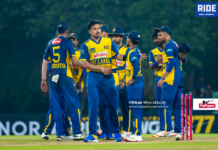This weekend saw some interesting rugby matches. Royal v Peters was entertaining and had some good technically superior rugby shown by both teams. Science and Patana did the same. Both games yielded 21 tries, which is really good entertainment for those who buy tickets or watch online.
STC and SJC then contrived to play out an exciting, if slightly comical encounter. The players were scrappy, and the refereeing a little unfortunate, although the 2 point margin kept everyone on the edge of their seats. Trinity thrashed Kingswood.
The talking point coming out of the two best games though is the maul. It is something both Royal and Isipatana, the two unbeaten teams, use in their armoury. One issue arises with a defensive tactic that SPC uses, while the other centres around the driving of the maul as displayed by Patana agains Science.
Let’s have a look at what all the fuss is about.
What is a maul?
The definition of a maul, found in the Law 17 shows what is required to form a maul. The simplest way to describe it, is that a maul is formed with the ball carrier and one player from each team, i.e. – a minimum of 3 players and a maximum of 30, obviously.
The key thing to note here though is that a maul requires players from BOTH teams. Therefore, if a team chooses not to engage with the opposition a maul is not formed. In the Peters game, that’s what Peters opted to do as a defensive tactic. They refused to engage with the line out drive, and therefore, there was no maul formed. Now Royal kept driving forward and the Peterite support wanted that drive called for being illegal. They may have a point, but then again they might not.
Defenders not engaging
The way the maul works is that the line out driver USUALLY comes down, is tackled by the opposition and then his team mates bind on to him. Now the engagement by the opposition and his team mates is almost simultaneous. Usually. However, in this game, SPC chose not to engage, and the jumpers own team bound on to him. In that instance, there is no maul. The only question then, is whether this pseudo maul can keep going forward.
The basic offside rule, without getting technical, is that no players can be in front of the ball carrier. Therefore, if the jumper is the first man in the maul, and it is heading towards the opposition, and the jumper still has the ball in his hand, then SPC may not be justified in being upset. The issue is that it is impossible as a defensive side, and sometimes even as a referee, to see which player has the ball in his possession. So they don’t know whether to come around, or sack the foremost player. It’s practically a really impossible situation to be in. Also, the referee has to guesstimate whether the jumper has the ball in his hands or whether he has transferred it another player even though that player is not the last man in the maul.
SPC’s tactic didn’t work. Royal presumably kept the ball up front and kept driving. The only issue for concern is whether a ball carrier can keep moving forward with players bound onto him. Forwards attacking the goal line often use the tactic called ‘doubling up’ where they bind on the ball carrier and hit the defence with two bodies. Technically this is hittin the defence with more than two bodies.
So is it illegal? I honestly don’t know. It’s an interesting question though.
When Does A Maul End?
As far as the maul was used on Sunday, it was nice to see Science being able to repel the Isipatana maul, because teams often complain that the maul cannot be defended. Science did so admirably using their strength and good body position. More than a few Isipatana mauls were disrupted.
The ones that did work however, seemed to change lanes. Is this allowed? I don’t think so. And if it is, it shouldn’t be.
What happens with Isipatana is text book stuff when executed well. Deyshatha throws to Sarathchandra at no.2, he is quickly bound on by his big front rowers and they transfer the ball back to Omalka Gunaratne who binds on to the back of the maul with one arm. When the maul is stopped, or driven back, The two or three players ahead of Omalka usually break away and keep going forward with the ball carrier still bound on by one arm. Other players then rejoin from behind Omalka and he expertly transfers himself to the back of those players, all the while remaining bound by one arm and holding the ball in the other.
It all sounds complicated but it happens in a flash. The only problem is that when the ball carrier leaves the original maul, that maul ends. In my interpretation the pod of players that break away from the back and then run into the opposition with the ball carrier behind him, are effectively acting as shields and therefore obstructing the defence as they are NO LONGER in the maul. Remember the maul needing three players with at least one from the opposition? When the pod breaks away from the back of the maul that has stopped going forward, then they are no longer in a maul and players without the ball cannot be in front of the ball carrier. This is commonly called ‘truck and trailer’.
This was a tactic perfected by Clive Woodward’s team of 2003 and has since been excellently copied by teams around the world. Isipatana do it very well. However, whether it is absolutely legal within the letter of the law is questionable? I certainly don’t know the answer to the question, and can only testify to the fact that international teams still do it, so those guys must know what they’re doing.
It will be an interesting one for Garratt Williamson, the SL referee consultant to have a look at with referees and coaches from all the teams. It’s a really interesting area of the law for me as a rugby nerd, but I can understand why it will be confusing for spectators. Hopefully, we can clear up the confusion and look forward to some excellent rugby.
Just for the sake of completeness, the other important rules concerning a maul are:
1. Arriving players must join from behind the hindmost foot.
2. All players must remain bound to be part of the maul.
3. It cannot be collapsed.
4. If it stops moving forward, the referees need to ask the team to ‘use it’, and if it stops again then award the ball to the defending side.
5. If a maul ends unsuccessfully, a throw in is awarded to the defending team.
Personally, I think the onus should be on the team forming the maul to get everything right. Just like the benefit of the doubt going to the batsman in cricket, it should probably go to the defending side in a maul, given that it is just such a difficult weapon to counter. Fittingly, both unbeaten teams are very adept at this practice while other teams are average. That shows on the points table.













